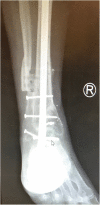Retrograde Hindfoot Nailing for Acute Trauma
- PMID: 30047003
- PMCID: PMC6105487
- DOI: 10.1007/s12178-018-9507-y
Retrograde Hindfoot Nailing for Acute Trauma
Abstract
Purpose of review: The role of retrograde hindfoot nailing in the treatment of acute orthopedic trauma is explored.
Recent findings: Tibio-talar calcaneal (TTC) nailing is an acceptable treatment alternative for the low-demand geriatric patient with peri-articular ankle trauma permitting immediate weight-bearing with low rates of complication and return to functionality. Hindfoot nailing can be used for limb salvage in the younger active patient; yet, joint-preserving reconstruction is preferred when feasible. Retrograde TTC nailing is a reliable option for hindfoot/distal tibia stabilization especially in the elderly frail population. Hindfoot nailing is reserved for a select subset of active patients when severity of bone, joint, and soft tissue injury are not amenable to more conventional reconstruction.
Keywords: Geriatric ankle fracture; Hindfoot nail; Limb salvage; Primary ankle fusion; Tibio-talar calcaneal nail.
Conflict of interest statement
Conflict of Interest
Both authors declare that they have no conflicts of interest.
Human and Animal Rights and Informed Consent
This article does not contain any studies with human or animal subjects performed by any of the authors.
Figures





References
-
- Amirfeyz R, Bacon A, Ling J, Blom A, Hepple S, Winson I, et al. Fixation of ankle fragility fractures by tibiotalocalcaneal nail. Arch Orthop Trauma Surg. 2008;128(4):423–8. Thirteen patients were treated with either a long humeral nail or a short TTC fusion nail through the same approach. All patients returned to their baseline function regardless of the hardware used, and radiographic analysis showed fracture union in all cases. Findings reinforced that the benefits of TTC nailing, early weight-bearing, and fewer complications outweighed the stiffness that resulted from the joint immobilization in the geriatric population. - PubMed
-
- Fourman MS, Tarkin IS. Retrograde tibiotalocalcaneal hindfoot nail without joint preparation is a viable salvage technique for geriatrics with extensive comorbidities and minimal ambulatory status following major trauma Proceedings of the American Academy of Orthopaedic Surgery Annual Meeting; Orlando, FL; March 2017. Here, we describe our institutional experience with acute TTC nailing following orthopedic trauma, which included a total of 18 patients treated after high- and low-energy injuries. Joint preparation was only performed in those patients whose traumatic wounds permitted access. Despite a significantly co-morbid population (mean Charlson Index 3.9) and a high percentage (22.2%) of high-energy trauma, limb preservation was possible in 88.9% of patients, and 83.3% were able to return to weight-bearing as tolerated.
Publication types
LinkOut - more resources
Full Text Sources
Other Literature Sources
Research Materials

